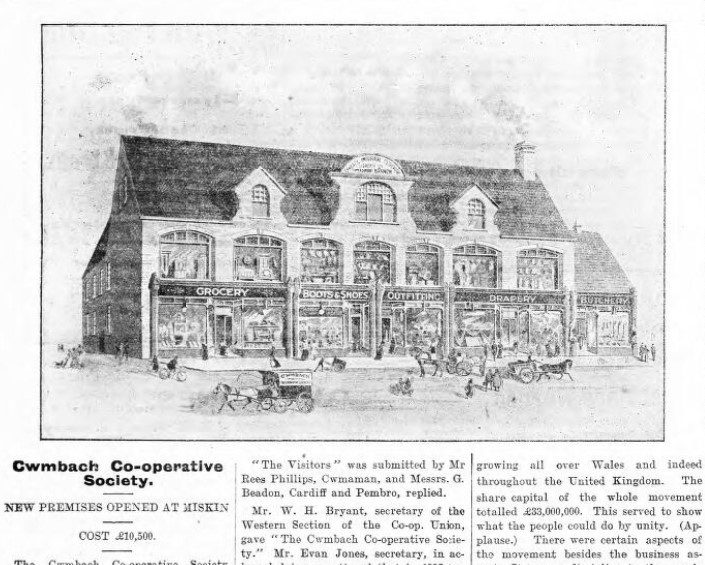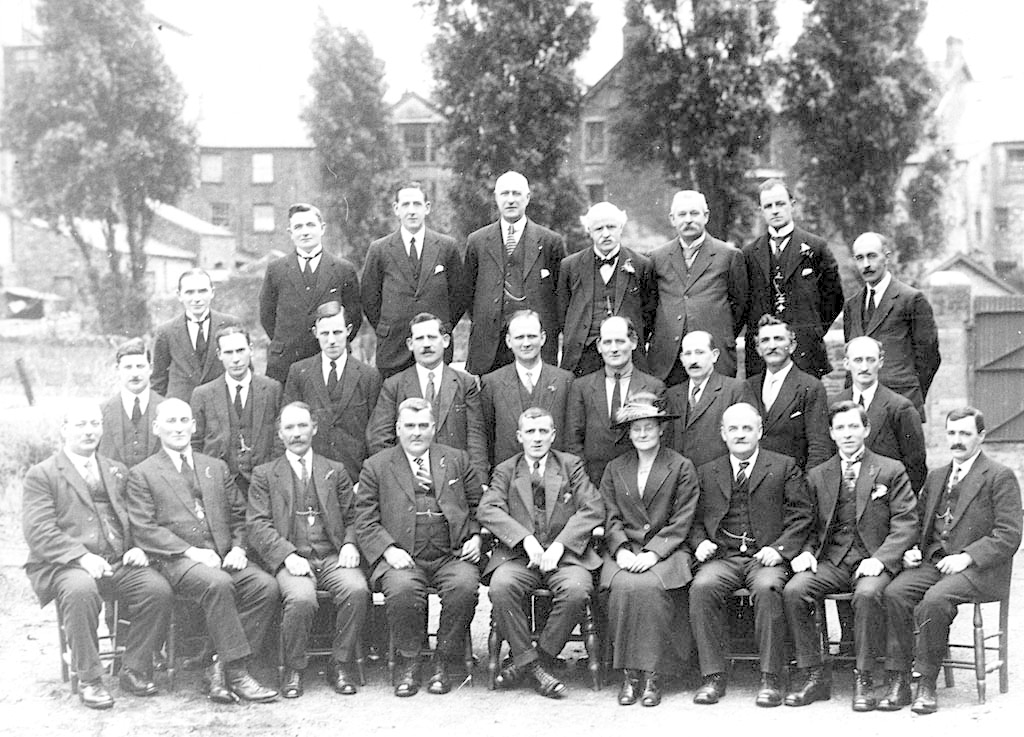The emergence of Co-operative Societies, 19th century
The first co-operative societies in Wales were established in the South Wales valleys.
They were modelled on the Rochdale Pioneers of England, established in 1844. The Rochdale Society of Equitable Pioneers was a group of 28 weavers, silk workers, and other artisans who had suffered from the mechanisation of the Industrial Revolution. They combined their efforts to create business principles that would benefit them.
After several failed attempts at co-operation elsewhere, the Rochdale Principles were established and in December 1844 they opened their store to sell butter, sugar, flour, oatmeal, candles and more. Within 3 months, they had established themselves as the provider of quality goods and services.

The Rochdale Society’s original store on Toad Lane, Rochdale, UK. This image is from the Wikimedia Commons, taken by “Scarletharlot69″ License CC BY 3.0.
So, how does a Co-operative Society work?
The main idea of a co-operative is that the business is owned by its customers. Thus, everyone works together for a common goal, that being good service over the pursuit of profit.
Therefore some of the principles include voluntary/open membership, democratic control, distribution of surplus in proportion to trade, payment of limited interest on capital, political and religious neutrality and promotion of education.
Other important aspects include:
- Members: Individual members have great importance. All members are given an equal vote on matters, thus, without active participation, there is a risk that societies fall into decline.
- Committee: Co-operative Societies were initially local autonomous organisations, managed by a committee. Any eligible member could stand for office and the elected committee was responsible for the society membership.
- Staff: The conditions for staff working for Co-operative Societies were often preferable, as their working terms and conditions improved over time. This included wages and bonuses, the length of the working week, annual holiday, paid sick leave and employment prospects.
First in Co-operatives in Wales
Most scholars recognise The Cwmbach Co-operative Society as the first established Co-operative Society in Wales.
However, there are historians that suggest that Wales birthed the very first co-operative society of any kind in the United Kingdom (before the Rochdale Pioneers). In his book, Dr. William Price: Wales’s First Radical, Dean Howell suggests that Dr. William Price ‘created social history by opening the first co-operative in Wales’, the Pont-y-ty-Prydd Provision Company’ around the 1820s. The company enquired with wholesalers from other districts to supply them with bulk goods which could then be sold to the workers.
Sadly, the co-operative was short-lived (defunct by 1842). It is believed that the heavy weight of boycotting from local shopkeepers was a key factor. While others argue that Dr. Price caused the business to fail by offering too much credit to the striking workers of the Newbridge chain works, causing bankruptcy.
The Cwmbach Co-operative, 1859
Thereafter came the Cwmbach Co-operative Society, which became more established than its predecessor. Founded in 1859 by John Rees, a collier, and David Thomas, a mechanic at the Lletty Shenkin Colliery. Inspired by the Rochdale Principle and the overwhelming poverty suffered by their community as a result of the miners’ strike of 1857 when the colliery owners closed the company provision shops.
The first meeting was held on October 9th, 1859, at the Mount Pleasant Inn during which fifty-six members joined. The society found suitable premises at cottages known as Capel Bricks. On March 8th, 1860 their first store was opened.
During this time the Society was known as Messrs. D. Thomas and Co. Limited, in honour of their founding member. Later, however, it adopted the title of Cwmbach Industrial Co-operative Society Limited.

This portrait, which sits proudly in the main museum exhibition, is of the Cwmbach Co-op’s last surviving founding member, Mrs. Ann Williams, with the Miskin branch, which she opened in 1909. Image taken by volunteer, Geoffrey Evans.
On September 2nd, 1909, a new branch of the Cwmbach Co-operative Society was opened in Miskin, Mountain Ash.
An issue of The Aberdare Leader in 1909 documents the details of this event. The article details that ‘Chairman of the Society, Mr. Edward Howells, called upon Mrs. Ann Williams, Cwmbach, aged 87 and the only living lady pioneer of the Society to declare the building open.’ As part of the ceremony, Mrs. Williams was presented with a ‘massive silver key with which Mrs. Williams opened the door, bore the following inscription “Presented to Mrs. Ann Williams, Cwmbach, by the members of the Cwmbach Co-op Society, on the opening of the new premises at Penrhiwceiber, September 2nd, 1909.’ The building had an area of 6,000 sq. ft. and the length of the shops were 100ft.

Aberdare Leader article, September 2nd 1909. Entitled Cwmbach Co-operative Society, New Premises opened at Miskin, Cost: £10,500.
The article describes how the basement had ‘grocery, boot and shoe departments, outfitting, millinery, and butchering department and official packing stores.‘ Also, the first floor provided ‘ironmongery, furnishing, flour and paper departments and workrooms.‘
The second floor included store rooms and committee rooms. They also have large areas reserved for production, including a ‘building with generating station, a six stalled stable and cart house, bakehouse with two ovens, mixing rooms with electric motor-driving kneader and hoist above, and gas house with coal house attached.’
The Cwmbach Co-operative demonstrated that co-operation was a reliable and long-term economic enterprise. It showed that people no longer had to rely on private shopkeepers and that members could organise their own economic affairs.
At least 14 other societies were also established in the Aberdare Valley in the 19th century, based on individual villages, such as Abercwmboi (1865), Penrhiwceiber (1867), Aberaman (1874), Cwmaman (1883), and Mountain Ash (1892).

Cwmbach and Aberaman Co-operative Society Limited officials and directors, circa 1925. Image 02/a/063 reproduced by kind permission from Rhondda Cynon Taf Libraries.
The co-operative movement grew steadily throughout the first half of the 20th century. In 1890, there were 44 societies in South Wales, which had 12,787 members and £468,994 trade between them. Over time more than 250 separate societies were set up across wales.
By the early 1950s, the co-op movement in Wales had grown and consolidated to have over 330,000 members in more than 80 independent societies, through their association with the national Co-operative Retail Society (CRS).
Subsequent Society Amalgamations
During the early part of the 20th century, the society began to lose trade, mainly due to stiff competition from the Aberdare Society which regularly offered a higher dividend than the Cwmbach Society and the effects of industrial action in the coal industry.
In the late 19th and early 20th century, Cwmbach was the dominant Co-operative Society in South Wales. However, throughout the 20th century they began to lose trade, mainly due to the ramifications of the 1920’s miners’ strike and stiff competition with other societies.
To make matters worse, in 1924 the Aberdare (1869) and the Trecynon (1865) Co-operatives formed together to amalgamate their resources and services.
As a result, the Cwmbach Co-operative joined the amalgamation in 1927. This formed the creation of the Aberdare and District Co-operative Society. The annual sales for the amalgamated society later became higher than for any other Welsh co-operative society.
This blog has been possible thanks to funding from National Lottery Heritage Fund
Want to read more? Discover the great impact and decline of The Aberdare and District Co-operative Society, in PART TWO – FOLLOW THIS LINK!
SOURCES:
- BBC Website, The co-operative economy in Wales – https://www.bbc.co.uk/wales/history/sites/themes/society/industry-cooperative-economy.shtml
- The Aberdare Leader, September 2nd , 1909, Newspapers Online – https://newspapers.library.wales/view/3578396/3578398
- Dean Howell, Dr William Price: Wales’s First Radical, 2012, Amberley Publishing
- Rhondda Cynon Taf Library Service ‘Our Past’ – http://webapps.rctcbc.gov.uk/heritagetrail/english/cynon/cwmbach.html
- Rhondda Cynon Taf Library Service Digital Archive – https://archive.rctcbc.gov.uk/quick-search?q=co-operative%20society&WINID=1609929243513
- Coalfield Web Materials – http://www.agor.org.uk/cwm/themes/co-op/co-ops.asp





This is so interesting!
My farther delivered milk with a horse and cart for the co-op
I remember the co-op in Miskin really well. We lived nearby. My best memory was of the butter! Welsh, salt butter with the salt crystalising on the thick greaseproof wrapping paper! Yum! One of my young neighbors worked there using butter pats to shape the packs of butter!
My first job in the late 60’s was in the Furnishing Office at the large Pontypridd store. That came under the Ynysybwl district co-op as was the Abercynon branch where we moved to in the 60’s. The Abercynon branch was quite large and sold so much. Furniture, shoes, groceries and butchers shop. I can still remember my mother’s dividend number!!Happy memories!
I worked in abercynon coop 1972 it was the ynysybwl cooperative